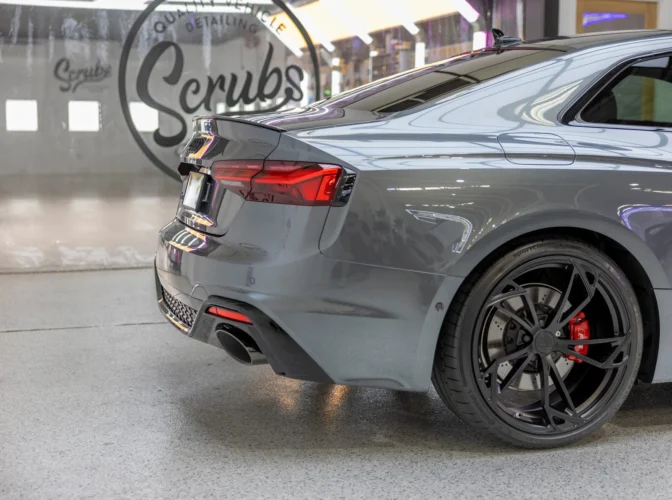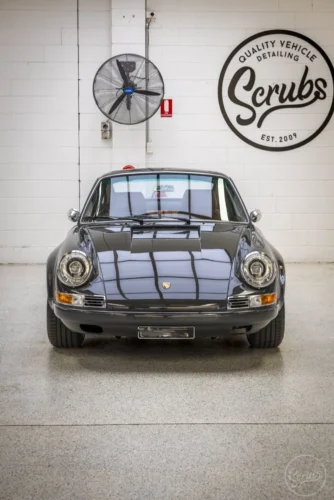The Lifespan of Ceramic Coatings (And What Can Ruin It Fast)

Key Highlights
- Professional ceramic coating lifespan: typically 3–7+ years with care.
- UV exposure, poor washing habits, and neglect shorten performance.
- Avoid automatic car washes, harsh detergents, and abrasive materials.
- Annual professional maintenance can extend protection significantly.
- Controlled application environments ensure the strongest possible bond.
When you first see a freshly coated car, it’s easy to think that mirror-like gloss will last forever. After all, ceramic coatings are often described as “permanent” protection — the ultimate way to lock in shine and shield your paint for years. And while that’s mostly true, the reality is more nuanced.
A ceramic coating is built to last, but it’s not invincible. Its lifespan depends on how it was applied, where the car lives, and how it’s cared for afterward. Some coatings stay slick and glossy for years, while others start to lose their edge much sooner — usually because of a few simple mistakes that are easy to avoid.
If you’ve ever wondered why one coating outlasts another or why some lose their hydrophobic performance too soon, the answer often lies in what happens after installation. Understanding what extends (and ruins) coating life can help you keep that showroom finish looking new for far longer than most drivers ever manage.
What Ceramic Coating Is Designed to Do
At its core, a ceramic coating is a highly durable form of paint protection made from silica-based compounds (SiO₂). When applied to a vehicle’s surface, it chemically bonds to the paintwork, forming a dense, transparent layer that’s far tougher than traditional waxes or sealants. This layer is designed to resist environmental stress — things like UV rays, heat, bird droppings, bug residue, and even the mild chemicals found in road grime.
Unlike wax, which simply sits on top of the clear coat, a true ceramic coating fuses with the paint itself. That bond is what gives it its famous durability and hydrophobic properties — the way water, dust, and dirt bead up and roll off instead of clinging to the surface. It’s also what makes it semi-permanent. A properly applied coating doesn’t wash away or evaporate over time; it can only be removed through abrasion, polishing, or sanding.
However, a ceramic coating’s job isn’t to make paint indestructible. It’s designed to preserve the finish, not replace proper washing or maintenance. Think of it as a long-term shield — one that can handle daily wear far better than wax, but still needs care to keep performing as intended.
Realistic Lifespan Expectations
One of the most common questions car owners ask is how long a ceramic coating actually lasts. You’ll often see claims of “lifetime protection,” but in real-world conditions, even the best coatings have a lifespan — and that lifespan depends on the quality of the product, the environment, and how well it’s maintained.
Professional-grade coatings, when applied correctly in a controlled studio, generally last between three and seven years, sometimes longer with regular upkeep. That estimate assumes proper washing, occasional decontamination, and avoidance of harsh chemicals. In comparison, spray-on or DIY coatings may last only a few months before their hydrophobic effect fades and protection weakens.
A good way to think of coating longevity is in phases. The first few years deliver peak performance: strong gloss, fast water beading, and easy cleaning. After that, the coating continues to protect the paint, but its surface behaviour — like slickness and water repellence — can gradually decline. This doesn’t mean the coating has failed; it’s simply entering a natural stage of ageing.
Factors such as heat, sunlight, and washing habits can accelerate or slow that process. In hot, UV-heavy climates like Brisbane, a professionally applied and maintained coating will still outperform any short-term product, but it needs the same care you’d give to any high-quality finish.
A realistic expectation isn’t that a coating lasts forever, but that it performs reliably for years — long enough to make it a genuine long-term investment in your car’s appearance and value.
The Factors That Affect Longevity
How long a ceramic coating lasts comes down to a simple balance — protection versus exposure. The coating itself doesn’t fail overnight; it slowly wears due to environmental stress, physical abrasion, and chemical breakdown. The better you manage those factors, the longer your coating stays strong.
Climate plays a major role. In cities like Brisbane, where humidity and UV levels are high year-round, coatings work hard to protect against constant sun and moisture. That environment can shorten lifespan if the coating isn’t properly maintained, which is why local installers apply and cure coatings in temperature-controlled studios.
Storage also matters. A coated car parked indoors most of the time will easily outlast one that sits in open sunlight every day. Garage-kept vehicles benefit from fewer UV cycles and less exposure to airborne contaminants, meaning their coatings retain that “just detailed” gloss for longer.
Then there’s washing technique. Using pH-neutral shampoos and soft microfiber towels helps preserve hydrophobicity — the slippery surface that makes water bead and roll away. Aggressive scrubbing, stiff brushes, or harsh detergents strip away the top layer of protection and dull the finish prematurely.
Even driving conditions can make a difference. Coastal air carries salt, industrial areas add pollutants, and frequent highway driving increases exposure to tar and iron fallout. These contaminants build up slowly, but if they’re not removed through proper washing or periodic decontamination, they start to erode the coating’s performance.
Ultimately, a ceramic coating’s longevity isn’t just about the product. It’s about how well you protect the protection.
What Can Ruin a Ceramic Coating Fast
Even the most durable coating can fail early if it’s exposed to the wrong conditions or handled the wrong way. The good news? Almost all premature coating failures come down to avoidable habits. Knowing what to steer clear of can make the difference between three years of protection and seven.
One of the biggest culprits is automatic car washes. The harsh detergents, stiff brushes, and recycled water in most machines are extremely abrasive. They can strip away the coating’s hydrophobic top layer within weeks and leave behind fine scratches that dull the finish. Even “soft-touch” tunnels are risky — they often trap grit from previous vehicles.
Another silent coating killer is improper washing at home. Using household cleaners, dish soap, or high-alkaline products removes oils and polymers the coating relies on. Over time, this weakens the surface and reduces its ability to repel water and dirt. Using the wrong cloths — like cheap sponges or rough chamois — can also create micro-marring that ruins the coating’s uniform finish.
Neglect is just as damaging. Leaving bird droppings, tree sap, or bug residue on the paint for too long allows acids to etch through the coating. Similarly, failing to remove iron and tar deposits through periodic decontamination lets contaminants embed themselves in the surface, dulling gloss and reducing slickness.
Lastly, improper installation can doom even the best product. If the paint isn’t thoroughly cleaned and corrected before coating, or if curing conditions are wrong, the bond between the coating and paint won’t form correctly. That’s why professional installers use temperature-controlled environments and measured curing times — the process matters just as much as the product.
A ceramic coating will only protect as well as it’s treated. The more care you take in maintenance, the longer it continues to do its job.

The Role of Professional Maintenance
A ceramic coating might be tough, but it still benefits from expert care over time. Professional maintenance helps the coating stay in peak condition and ensures it performs exactly as intended — especially in the years after application.
Most professional installers recommend an annual inspection or maintenance service. During that visit, technicians assess how the coating is holding up, perform a light polish if needed, and reapply a top coat to refresh the hydrophobic layer. This small effort can extend protection well past its expected lifespan.
Professionals also have the right tools and environment to carry out decontamination safely. Iron removers, clay bars, and neutral cleaners are used carefully to lift bonded contaminants without harming the coating. These treatments restore slickness, rejuvenate beading, and prevent long-term dullness.
More importantly, professional studios maintain controlled environments for every step — temperature, humidity, and curing all affect how a coating bonds. This ensures consistent results and prevents premature breakdown caused by improper installation.
For owners, partnering with an experienced detailer means never having to guess what the coating needs next. The installer can tailor maintenance advice to your driving conditions, storage habits, and specific coating type — ensuring you get full value from the investment.
Conclusion
A ceramic coating can transform how a car looks and how easy it is to maintain, but longevity depends on much more than the product alone. From the moment it’s applied, every wash, every environmental exposure, and every bit of maintenance adds up to determine how long it lasts.
When cared for correctly, a professionally applied coating can perform beautifully for three to seven years or more — maintaining gloss, resisting contaminants, and shielding your paint from Brisbane’s tough climate. But when ignored, even the best coating can lose its edge within months.
Think of ceramic coatings as long-term protection, not permanent perfection. They’re a shield that rewards care, honesty, and professional craftsmanship. When you treat them right, they do exactly what they’re designed to — keep your car looking better for longer, year after year.
Read more on
MyCarHeaven are on Instagram. Go check us out and do follow us.
Go visit the MyCarHeaven Instagram page. We post regular quality content, predominantly focused on classic cars, supercars, hypercars and car shows. We also feature all our competitions here, where you will have the chance IF YOU FOLLOW US and you follow the competition entry criteria, you could be in with a chance of winning tickets to the best UK car shows, and other automotive stuff.
Go to the MyCarHeaven Instagram account here. Advertisement
Advertisement Advertisement
Advertisement Advertisement
Advertisement Advertisement
Advertisement




